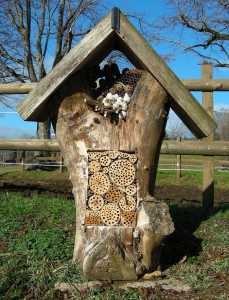
Osmia, a species of mason bee, is a highly beneficial pollinator.
Want to take steps to support a locally found, native pollinating insect? Consider the Mason bee
With national pollinator week approaching later this month, it is important to recognize the variety of pollinators that exist in addition to Honey bees. For those who want to take steps to support a locally found, native pollinating insect, consider the Mason bee.
Mason bees are major pollinators of orchards and some commercial crops, but you can sometimes find them buzzing around a backyard garden. All told, there are 140 species of Mason bees in North America. They are about a ½ inch in length and can vary in coloration across species. Some Mason bees will be metallic green, while others are dark blue or black. Others resemble a small black fly, but flies only have one pair of wings and bees have two pairs.
Just as a brick mason uses a concrete mortar to set bricks, Mason bees use mud to construct their nests in preexisting cavities. The male Mason bee does not sting. A female is considered non-aggressive, stings only when handled ‘roughly,’ or when trapped under clothing.
These bees tend to favor tube-shaped or asymmetrical flowers such as plants from the mint and legume families. One Mason bee in particular, the Blue Orchard bee, is a popular commercial pollinator. It emerges in the spring, before honeybees. As a pollinator, this early spring work makes this species of bee more efficient than Honey bees when pollinating certain orchard crops. They are able to visit more flowers and can transfer pollen more effectively.

This creative bee hotel uses bamboo and holes of the proper sizes drilled in logs to attract solitary bees. And it’s kind of fun to look at too.
If we followed one Honey bee and one Mason bee, you would find the Mason bee a harder worker that visits more flowers. But we use Honey bees because we are able to move multiple hives with tens, if not hundreds, of thousands of Honey bees into a location to pollinate a crop. To the contrary, Mason bees are solitary bees. Though we can move them around, agricultural producers cannot move enough numbers of them around to compare with the more popular Honey bees. Plus we get honey from Honey bees!
The solitary Mason bees chose nest locations in hollow stems, cracks in between stones, and cavities in wood. In the spring when Mason bees emerge from their nest, the females will mate and then will search for a new nesting site soon after. She will collect pollen and nectar to create a mixture that is used as provisions for developing brood.
Increasing the number of Mason bees around your home garden requires much fewer materials than a hive for Honey bees. You can provide a nesting site for Mason bees just outside a window of your home, just like you would hang up a bird house to watch them from the comfort of your chair.
The nesting holes for Mason bees should be ¼ to 3/8 inch in diameter and at least 3 inches, preferably 6 inches, deep. The hole should be open only on the entry end. Mason bees prefer wood (not pressure-treated or cedar) in which to nest but will use other materials.
You can make Mason bee nesting sites by drilling holes into a block of wood. Place the nest in a dry, protected site preferably with east or southeast exposure. You can also take a large soup can or small coffee can and fill it with paper straws or hollow bamboo stalks of the right size. With wire or string, position the nesting can on its side and hang outside, preferably near a window where you can view it.
Several parasites, predators, and pathogens can injure or kill Mason bees. Being an insect, this struggle for survival has gone on for eons, and is a part of nature.
Pollinator week is June 21-27 this year. Lets do our part to support agriculture and care for the environment by helping our pollinators.
Written By: Cary Simms, Ag and Natural Resources County Agent, Texas A&M AgriLife Extension Angelina County